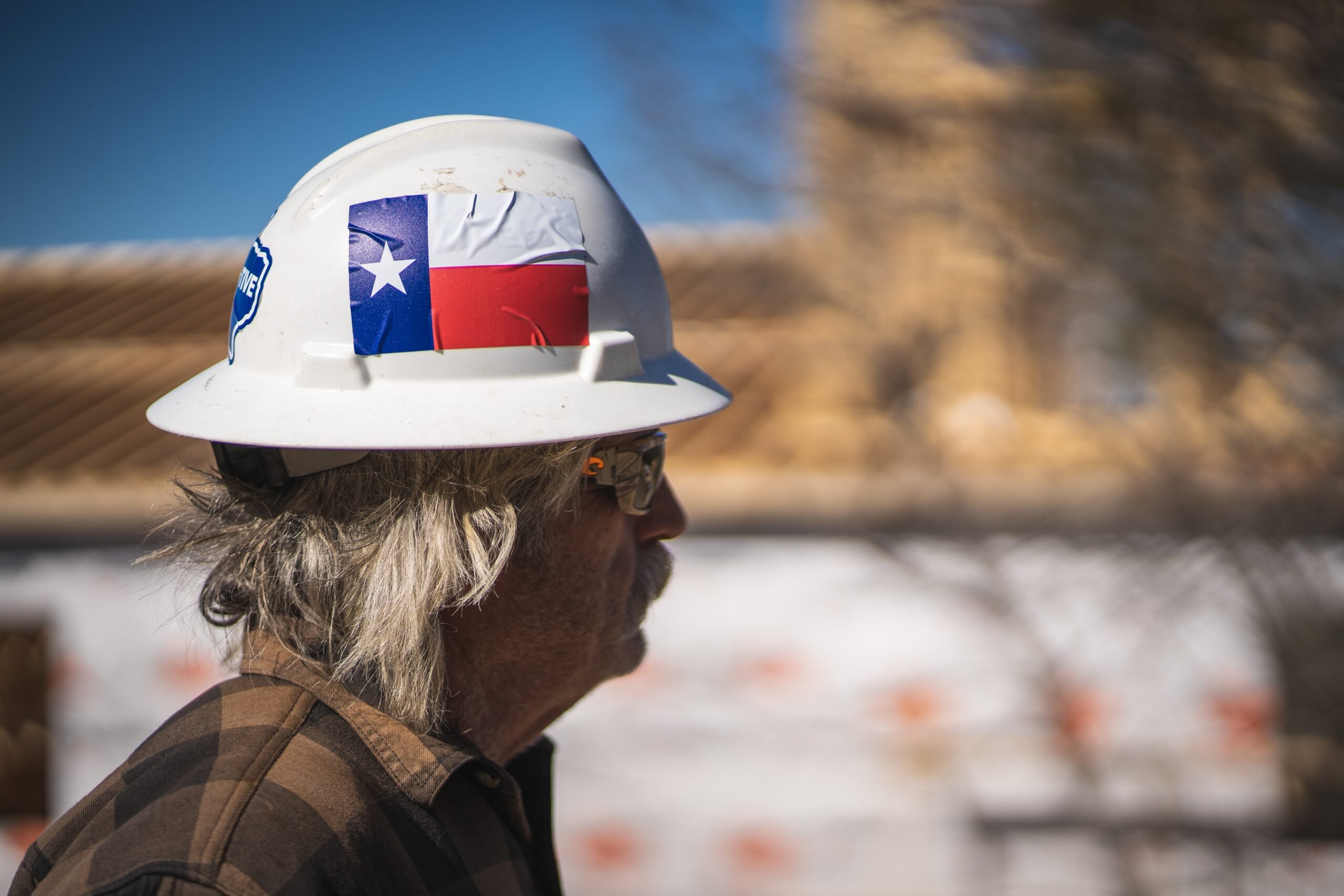Clearing the Air
How a working-class neighborhood fought a dirty industry and the TCEQ—and won.
Aaron Hartsfield already knew his signature had been forged on the document submitted to the Texas Commission on Environmental Quality. There was no way he had withdrawn his opposition to a biomass energy plant near his neighborhood in Lufkin. Nevertheless, he exploded in anger when the document arrived in the mail. So he marched over to a community meeting held by the plant’s owner, Aspen Power.
“I was hot. I went over to the community meeting and asked them who signed my name to something I didn’t want,” he says.
No one ’fessed up. But afterward, the alleged forgery and the stubborn determination of Hartsfield and other neighborhood activists succeeded in forcing Aspen Power to spend an additional $10 million dollars on air pollution controls at its plant. And it might lead to tougher emission standards for similar plants in Texas.
The battle between Aspen Power and low-income residents in Lufkin exemplifies the problems with renewable energy. Despite some activists touting these projects as solutions to global warming, and politicians promoting them as the key to economic prosperity, renewable energy projects tend to have their own sets of problems for local residents—probably none more so than biomass incineration.
There is no universally agreed-upon definition for biomass. Most often these projects mean burning organic material, usually waste wood, to create steam, which then turns power-producing turbines. Biomass incineration is considered to be a green alternative to coal because it produces fewer deadly gases, but because it still involves combustion, it remains controversial among environmentalists. And even if you agree that burning wood is better than burning coal, you don’t necessarily want a biomass plant next door. Hartsfield certainly didn’t, and he spent years fighting it in a case that dredged up accusations of racism, corruption and cronyism.
In 2007, the Lufkin Planning and Zoning Commission proposed to allow Aspen Power to construct a biomass incineration plant next to Hartsfield’s African-American neighborhood in north Lufkin. The plant would become the latest in a long string of forestry-related facilities in the same area. In an oversight of either towering arrogance or mind-numbing stupidity, the city failed to notify the people of north Lufkin about the plan.
It didn’t take long, though, for word to get around the mostly working-class neighborhood. Hartsfield and his neighbors got angry. They started a petition opposing the plant and sent it to TCEQ, the state agency that grants air quality permits. The neighbors began attending city council meetings and protesting. “There was a lot of people at those meetings and they were upset,” says Hartsfield. Residents accused the city of environmental racism. They raised fears about more pollution in a neighborhood that had for decades been filled with industrial fumes and noise.
Then a man named Eric Jones, an outsider, began organizing community meetings and talking to people about the benefits of the plant. He said it would bring good-paying jobs with a minimum wage of $15 an hour. Jones said he was there to educate people and insisted he was not on Aspen Power’s payroll. That turned out to be a lie. Jones was the point man of Aspen Power’s public relations strategy designed to win over the community, he would later say in a legal deposition.
Dr. Dallas Pierre, a neighborhood dentist, suspects Jones was only one element of a covert PR campaign run by Aspen Power owner Danny Vines. Pierre says he believes that Vines made donations to local churches to win support, but can’t prove it. Vines did sponsor a trip to Minnesota for neighbors and civic leaders to view a biomass plant in St Paul. Hartsfield and Pierre refused to go.
Trying to deflate concerns about pollution, Vines told the Lufkin Daily News that his plant was “capable of releasing no particulate matter into the atmosphere” when burning wood. But when called to testify, Bill Powers, a court-recognized air quality expert and consulting engineer opposed to the plant, explained that it is neither technically nor economically feasible to remove all particulate matter. In fact, the plant, as originally planned, would have produced so much pollution that it would have been “in violation of the Clean Air Act” according to Kelly Haragan, an environmental law professor at The University of Texas at Austin.
Nevertheless, the PR blitz paid off. The claims about pollution-free clean energy and the promise of good-paying jobs began to displace concerns about pollution, noise and truck traffic. In the Lufkin Daily News, letters of complaint were joined by letters of support. The community meetings got larger and turned more favorable toward the plant. Pierre complained publicly about “people, blacks and whites, from areas other than the immediate area of the proposed plant emerging from the woodwork attempting to dissuade North Lufkinites from opposing the industrial complex.”
The mood in the community turned toxic. Plant opponents were harassed. Pierre had his north Lufkin dental office picketed. “My office was vandalized,” Pierre says. “And I lost business.”
The city council, emboldened by shifting public opinion, passed the zoning change in August 2007. And happily for Vines, right wing state Rep. Wayne Christian had sweetened the deal by quietly passing House Bill 1090, which included a $20-a-ton state subsidy for waste wood fuel. Burning wood was probably going to be even more profitable. Now all Vines needed was an air quality permit from TCEQ.
Vines’ history of environmental compliance has been less than stellar. He and his family have been involved in two Superfund clean-ups at businesses they owned. Five years after entering into a TCEQ Voluntary Compliance Program, one of the sites, Lufkin Creosoting, has still not completed remediation.
So Vines didn’t want any more trouble from protesters. He got a copy of the original petition sent to TCEQ complaining about pollution issues. “Everyone who signed got a visit,” Hartsfield says. Some would get repeated visits from company representatives or proponents of the plant. “They came by my house a number of times,” Hartsfield says. Proponents also visited an elderly neighbor who also says that her signature was forged on the letter that withdrew the earlier objections to the plant.
If TCEQ ever considered denying the permit, it certainly didn’t show it. The agency granted Aspen Power permission to begin construction while the permit worked its way through the bureaucracy, something forbidden under EPA rules. When local residents alerted the EPA, they ordered construction stopped.
Aspen Power didn’t have to stop for long, though. The air quality permit came through in July 2008. Aspen Power got the green light to build a plant that would spew out as much particulate pollution as some coal-fired power plants. But there were still those pesky hardcore opponents in north Lufkin who weren’t giving up.
Hartsfield, a slender, intense man who works the 3 p.m.-11 p.m. shift at the post office, was—and remains—one of the plant’s most steadfast opponents. He never signed a withdrawal letter. “It was a forgery,” Hartsfield says. He went to the District Attorney.
“At first they didn’t know what to do. They finally sent me to the police and after I didn’t hear anything from them for few weeks I went back, and they told me it was a state violation. That’s when I went to the Texas Ranger.” The ranger initiated a criminal investigation of Aspen Power. A case is under consideration by a grand jury.
The protesters also enlisted help from environmentalists who know the ropes at TCEQ. Nine in all, they headed for Austin and a showdown with the state agency.
The group wanted TCEQ commissioners to withdraw the air quality permit. The commissioners dismissed the appeals of those who complained about pollution and quality-of-life issues. But they could not ignore Aaron Hartsfield’s allegation that TCEQ relied on forged documents when granting the permit. In November 2008 Aspen Power’s air quality permit was withdrawn, and Hartsfield’s case was referred to the State Office of Administrative Hearings (SOAH). Administrative Judge Sarah Ramos stunned many by recommending denial of the air quality permit.
“Unfortunately SOAH decisions are not binding; they can only make recommendations,” says Enrique Valdivia, an attorney for Texas RioGrande Legal Aid who helped the protesters. “I’ve been before the TCEQ a lot over the years, and this is the worst set of commissioners we’ve ever had. And that’s saying something. They were probably going to grant the permit anyway.”
Valdivia’s low opinion of the TCEQ commissioners is shared by the EPA, which is now threatening to withdraw the agency’s authority to grant air quality permits. As a result, the commissioners—all appointed by Gov. Rick Perry—are now under tremendous pressure from the EPA to impose tougher standards. Aspen Power also found itself in legal limbo, and every day of uncertainty was costing it money.
The working-class protesters were also growing weary. They couldn’t keep disrupting their lives with expensive and time-consuming trips. Plus they were running the risk that the commissioners would grant a permit that would barely just manage to satisfy the EPA and would still expose them to pollution.
It was in everyone’s interest to settle.
Aspen Power attorney Robin Morse explains, “We made a business decision to settle. There was pressure from investors to move forward.”
In November 2009 Aspen Power agreed to what are “probably the most stringent air quality standards in the nation,” says air quality expert Bill Powers. “It’s going to cost them around $10 million to install state-of-the-art equipment that will cut pollution to about one quarter of what would be allowed under the old permit.”
“We got virtually everything we wanted,” he says.
The protesters’ attorney, Kelly Haragan, director of The Environmental Clinic at the University of Texas School of Law, was also happy with the settlement, at least on the environmental issues. “The Aspen case highlights the importance of public participation,” she says. “Without Mr. Hartsfield’s and the other protestants’ willingness to stand up for what they knew was right, in the face of serious opposition, the plant would have been allowed to emit excessive pollution, and the Lufkin community would be breathing much dirtier air in the years to come.”
Sierra Club’s Neil Carmen, who used to be an inspector for TCEQ’s air quality section, says that new biomass plants will be required to use the best available pollution-control technology. “The Lufkin plant will have that technology and other biomass plants will have to follow suit,” he says. “This settlement has set the bar much higher.”
But while the plant’s emissions should be cleaner, the people of north Lufkin will still have to live with a large, noisy, brightly lit industrial complex right next door to their homes and elementary schools.
“None of us were really satisfied,” Pierre says. They wondered if a notoriously slack TCEQ would effectively enforce the new standards—and what happens if it doesn’t? The protesters have the option of going back to the administrative judge if emissions are too high, but that could mean more court battles, lawyers and travel to Austin. “Aspen Power could get away with a lot by stalling their way through a new round of court battles,” he says.
The battle over the Lufkin biomass plant may be only the beginning of a larger environmental war in other parts of the state. The biomass industry is growing in Texas, especially in the forested east. Some mainstream environmental organizations, such as the Pineywoods Group of Sierra Club, have reservations. “Carbon dioxide output will be in the hundreds of thousands of pounds per year,” Powers says. That would add to the already-heavy load of CO2 that Texas is pumping into the atmosphere. Plus there is widespread concern that the demand for waste wood will actually hurt forests by removing the nutrients normally left behind as logging debris, which is the principal biomass fuel.
Environmental activist Dian Avriett, who lives near Austin Energy’s Sacul biomass plant, which is now under construction, fears that the plant will demand more than just logging debris and eventually start consuming forests. Avriett also worries the plants will start burning other waste such as railroad ties. “In fact there is really not much in the way of credible oversight of these plants,” he says.
In its rush to meet its goal of 30 percent renewable energy by 2020, Austin Energy is the only customer of the biomass plant. Even though biomass is often touted as “green energy,” it is unclear what standards Sacul will have to meet. The owner, Southern Company in Atlanta, has not responded to inquiries. Austin Energy has little say about the operation of the plant.
So unless TCEQ is forced to raise air quality standards, these plants may not be so green.
For the Philadelphia-based Energy Justice Network, which fights environmental racism, the larger question is whether biomass incineration is truly a better alternative to other forms of energy. Will it reduce pollution or simply create another dimension of the problem?
The network and some other environmental groups are flatly opposed to incinerating anything, and they are especially outraged that biomass incineration is so widely accepted as a clean alternative to fossil fuels. Some biomass fuels contain chlorine or other halogens and would create dioxins when burned, the group says. Another issue is the governmental rush to adopt alternative green energy sources based on political imperatives while not looking closely at how that energy is created. Definitions of biomass vary widely from state to state, as do regulations about what can be burned. In some places old tires and sewage sludge are considered potential fuels.
Another company with new Texas biomass plant at Woodville, 50 miles north of Beaumont, is now seeking an air quality permit. Construction will probably start late in 2010. At least three other similar plants around East Texas are in the planning stage. The Lufkin plant will be the first to go into operation sometime in late 2010.


